Posted on 19 April, 2018 by Africa Geographic Editorial in Research, Wildlife and the Decoding Science post series
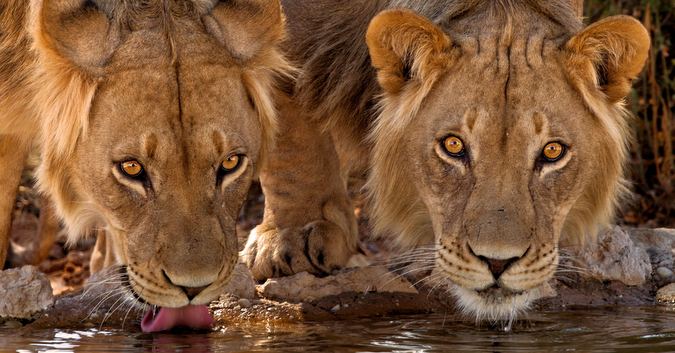
Lion brothers drinking in the Kgalagadi Transfrontier Park, South Africa © Fanie Heymans
The African lion (Panthera leo) was once described in Samuel Johnson’s Dictionary of the English Language (1755) as “the fiercest and most magnanimous of the four footed beasts”. This definitely rings true with these magnificent felines! It is quite clear that lions are fascinating creatures, and here we get to know them a bit better by looking at 15 facts about them:
1. African lions are the largest of the African cats (second largest in the family Felidae, with the tiger being the largest). Males can reach a shoulder height of around 1.2 metres and weigh around 150 – 225 kg (av. 189kg). Females are around 1 metre in shoulder height, and weigh between 110-152kg (av. 126kg).
2. African lions have a wide habitat, and can live almost everywhere – from open woodlands, thick bush, scrub and grass complexes, even penetrating deep into deserts along watercourses – though don’t expect to find them in rainforests. Globally, lions exist in Asia and in sub-Saharan Africa, though history shows that a long time ago lions also inhabited parts of southwest Asia and north Africa.
3. The colour of a lion’s coat varies from region to region, and within populations. However, it is found that lions that live in areas where it is either cooler or have higher humidity levels tend to have darker fur – such as the desert-adapted lions in Namibia and the black-maned lions of the Kalahari. You also get white lions, but these are not true albinos but are rather genetic variants with strongly reduced pigmentation.
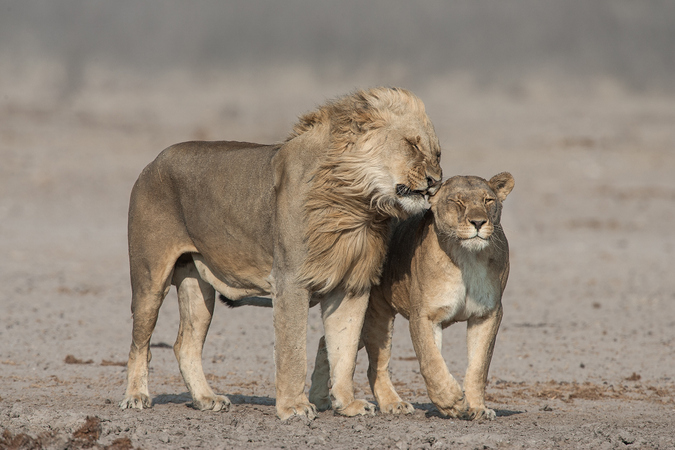
A whispering lion couple in strong wind in Etosha National Park, Namibia © Johan J. Botha
4. Speaking of desert-adapted lions. These lions are known for their majestic size and ability to survive the harsh desert environment. They have longer legs and leaner bodies than ‘regular’ lions, and are built for endurance. Because prey is sparse in the desert regions, lions have to search far and wide for food, and live off smaller prey, such as antelope, mice and birds. The lions have a stronger resistance to thirst and can go for up to two weeks without drinking water (they rely on their prey’s blood for moisture)
5. When it comes to claws, lions have four on their back feet, but five on the front where the dew claw is found. The dew claw does not show in their spoor (foot print), and acts like a thumb that is used to hold down prey.
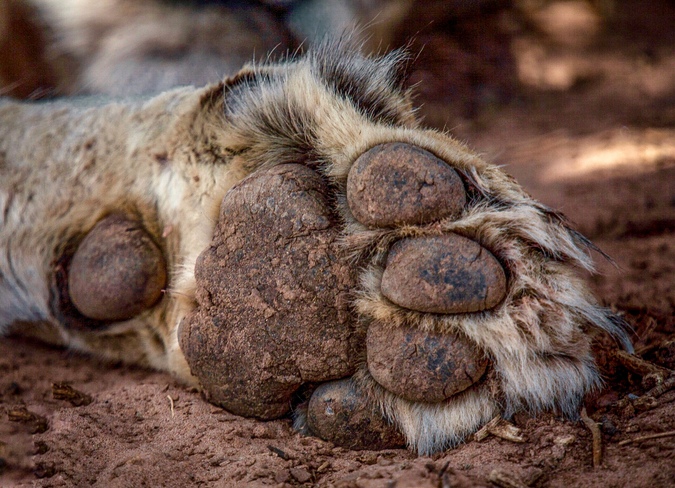
Close up of the front left paw of a lion in Samburu National Reserve, Kenya © Jaymin Patel
6. Upon closer inspection you will see that lions have round pupils, instead of vertical slits that are found in domestic cats. Having pupils that are vertical slits are handy for cats that are on the prowl for small prey and need to be able to focus clearly on the small stuff. However, larger felines such as lions generally hunt larger prey, so there is unlikely to be a significant advantage to having slit pupils. Having round pupils also allows more light to filter into the eye at night, giving the lion better night vision.
7. On the subject of eyes, lion cubs are born with blue eyes that change to amber or brown when around the age of two to three months.
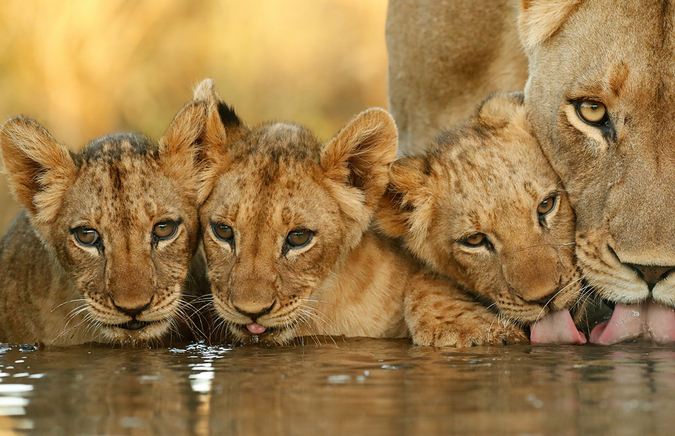
https://africageographic.com/wp-content ... imanga.jpg
8. Lions are the most sociable member of the cat familyand can be found living in prides of up to 25 individuals. The size of the pride depends on the area and prey availability. A pride will usually consist of 1-4 adult males, several adult females (one dominant), and a number of sub-adults and cubs. All pride’s lionesses are related. Female lions typically stay in the pride as they grow up whereas young males eventually leave the pride and attempt to establish their own prides. Young male lions ousted from prides often wander large distances in search of other ousted males, to form coalitions and attempt to take over a group headed by another male(s). New pride males will often kill the cubs in the pride and then mate with the females, to ensure that their genes prevail in the pride.
9. When it comes to hunting, lion prides will have different preferences to what prey species they favour, but due to their opportunistic nature, lions hunt a wide variety of game. Lions mostly target large-sized ungulates (buffalo, wildebeest, zebra and gemsbok). However, they don’t stop there, lions are known to take on larger mammals such as young elephants and hippos and will also scavenge and chase off other predators such as hyenas or wild dogs from their kills.
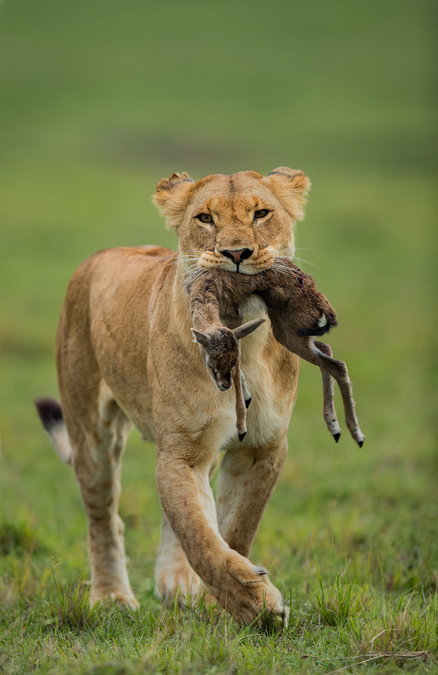
A lioness with her prey in Maasai Mara National Reserve, Kenya © Dev Raj
10. Hunting takes place mostly from dusk until dawn, and during the cooler hours of the day. Most of the time the females will hunt, and then the males (who patrol the territory and protect the pride) will eat first. The cubs compete for what remains once the adults finish. The only way to secure food is to fight for it, which is why you will often see displays of aggression amongst pride members when it comes to feeding time.
11. Lions will gorge themselves into a food coma when there is plenty of food available, and on days like this an average male lion will swallow around 15% of their body weight!
12. There is no fixed breeding season for lions, though pride females will often synchronise the timing of breeding, especially after a pride takeover by new dominant males, to ensure maximum food and maternal care available to cubs. Lions will mate roughly every thirty minutes (each mating lasting for around 20 seconds) for three days… nonstop! This is to ensure fertilisation during the females oestrus period so that the cubs will be born as soon as possible, allowing for longer protection under the pride male.
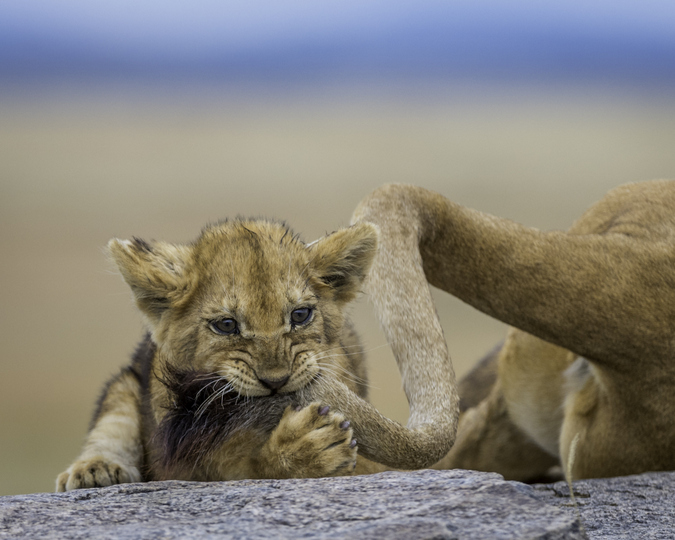
“Caught the cat by the tail” – a lion cub in Serengeti National Park, Tanzania © Yaron Schmid
13. A litter of 1-4 (sometimes up to 6) cubs are born after 110 days of gestation. Cubs suckle regularly for the first 6-7 months, then the frequency will decline after that. Cubs remain with their mother for two years or longer – at 11 months they begin hunting.
14. Lions have one of the most complex communication behaviours of any of the cats. They can make a variety of calls which include roars, grunts, moans, growls, snarls, meows, purrs, hums, puffs and woofs.
15. That said, it’s shouldn’t be a surprise to know that the lion is the king of the roar – it is the loudest of any big cat and can be heard up to 8km away! Lions roar for a number of reasons, from advertising territorial ownership and intimidating rivals, to locating other members of the pride and assisting in social cohesion. Another advantage to roaring is that female lions can recognise the roar of a male who belongs in their pride to that of an outsider – this helps the females keep a safe distance from outsiders who would most likely try to harm their cubs.
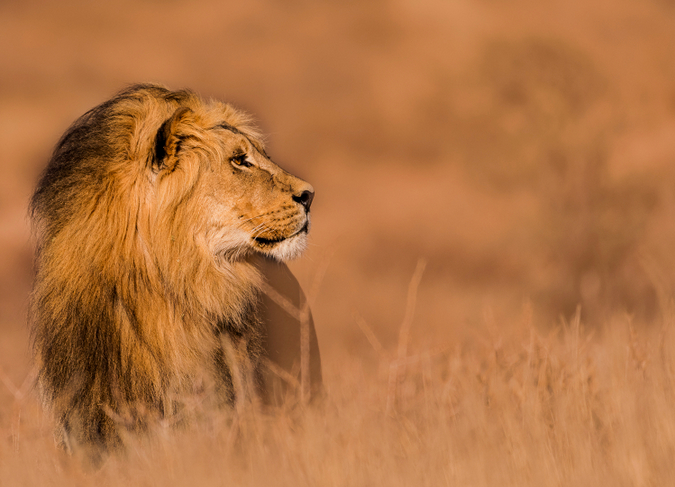
A male lion gazes towards his pride early one morning in the Kgalagadi Transfrontier Park, South Africa © Marc de Chalain


